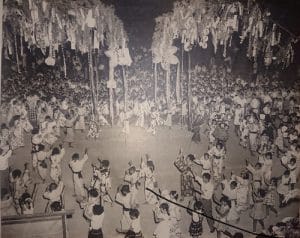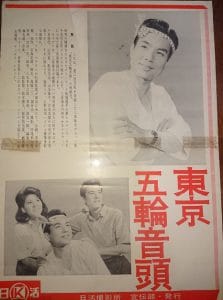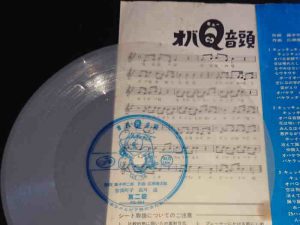Overview
Peace came after a period of postwar impoverishment and re-independence. Japan entered a period of rapid reconstruction and rapid economic growth. During this period, along with the rapid development of urbanization, the communities that had been the supporters of Bon Odori were in danger of disappearing. With the folk song boom, new trends appeared, such as local folk songs becoming nationally known and local ondo(dance songs) being created to revitalize the local community. Then came the era of the coexistence of a variety of Bon dances, such as Tokyo Ondo and Tankobushi, which were formed before World War II, and various Bon dances newly added after the war, in addition to Bon dances from the Muromachi and Edo Periods. On the other hand, with the diversification of entertainment, including the emergence of television, the Bon dance lost its element as a meeting place and a place for young people to explode with energy in the summer.
This Era
.
After the defeat in war, the country entered the period of rule by GHQ, which began the denial of prewar culture and education and the influx of North American culture. After postwar reconstruction, the country enters a period of rapid economic growth and the emergence of a middle class income earners. Mainstream media shifted from radio to black-and-white and color TV, and records and cassette tapes also became popular. The last stage of the Showa period is the bubble economy, and living standards and economic gains reach their zenith.
1951 San Francisco Peace Treaty
1953: Television broadcasting begins
1955-1973 High economic growth
1958 LP+single record sales overtake SP sales
1961 TV subscription overtakes radio
1964 Tokyo Olympics
1965-1970 Motorization
1970 Osaka World’s Fair
1973 Oil crisis
Color TVs overtake black and white
Cassette tapes become popular
1976 Magazine sales overtake book sales
1985 Appearance of karaoke boxes → Singing culture
1986 CD sales overtake vinyl sales
1986-91 Bubble economy
Basic Information
Population: About 100 million, period of rapid growth
Attribute type: Equal employment opportunities for men and women
Life expectancy: Around 70 years
Famine and disaster conditions: Earthquakes and typhoons occur once every few years. Fewer disasters in the late Showa period.
Media of transmission: Television developed into the center of mass media, magazines and comic books grew, and cassette tapes made recording easy
Territorial system: Individual land ownership
Clothes of the common people: Mainly Western-style clothes, Japanese-style clothes became Sunday best, and yukata (summer kimonos)
Food of the common people: White rice is the staple food, bread food also spreads. Western food becomes the main diet.
Dwelling of the common people: Wooden mortar houses with a blend of Japanese and Western styles, shift to nuclear families
Entertainment opportunities for the common people: Improvements in lifestyle and affordability due to rapid economic growth. Leisure activities became more diverse. The significance of Bon Dancing relatively decreased.
Bon Dancing: This Era
Several folk song booms, a large number of “ondo (dance songs)”
Bon Dancing This Era
Bon Dancing in the 1950s
Min-yo(folk song) records by Michiya Mihashi in the Showa 30’s (1955~1964) made million-seller records
.
Hokkai Bon Uta, Soma Bon Uta, Hanagasa Ondo, Aikawa Ondo, and other minyo songs became nationwide hits, largely due to the influence of Mitsuya Mitsuhashi’s records. Many of them have become classics of Bon Dancing.
Minyo(folk song) taverns stood side by side in Asakusa (Yoshiwara)
Minyo (folk song)boom around 1977
NHK’s “Minyo(folk song) for you” becomes popular as Japanese folk music. (singing in casual attire, etc.)
Completion of minyo records
Minyo(folk song) records
Kasho Machida → Tsutomu Takeuchi
The “Japan Minyo Taikan” (A Compendium of Japanese Folk Songs)
Showa 15 – Showa 55 (1940-1980) (mainland version)
1981 – 1991 Amami-Okinawa version
NHK’s major project for recording folk songs

Min-yo Taikan (folk song compendium)’s complete collection (photo reprinted from the collection of the Shonan Bon Dance Study Group)
Scoring, recordings, the sophistication of folk song singing, and the formulation of dances. Although effective for transmission, it tends to reduce regional color and individuality.
Massive and diverse ondo(dance songs)
(Reference: Nippon Dai Ondo Jidai, Hajime Oishi)
Ondo as National Music
Ondo for war spirit (during the war)
Postwar reconstruction, Constitutional ondo, new peace, etc.
Symbol of rebirth, Ondo for the Tokyo Olympics
Ondo as joke music
Tankobushi parody by the The City Slickers
1970s
The Drifters, Drifting Ondo (original song Hokkai Bon Uta), Higashi-murayama Ondo (original song recorded by Michiya Mitsuhashi )
Densen Ondo from the TV program “Migoro Tabegoro Waraigoro (It’s time to watch, eat, and laugh)”.
→Ondo (original song), Higashi-murayama Ondo (original song), Densen Ondo (Electric Wire Ondo)
→This song was very popular at elementary schools.
Bon dance reimported from overseas
Jagged Heart Lullaby from Brazil
Rise of folk dance groups
Groups (master and apprentice groups) were formed in each region.
They also played an active role in Bon Odori(Bon Dance) festivals.
Late Showa Period → Aging of the population in the Heisei Period
Stereotypical image of Bon Dancing
In the 1960s and 1970s, Bon Dancing became an event for children and the elderly. The element of fun for young people and a meeting place for men and women disappears. There are Bon dance competitions at elementary schools and Bon dances in physical education classes, and some of the images of wholesomeness and boredom is attached rather than folkloric color. For people living in urban areas, Bon Odori has come to be stereotypically associated with “Tankobushi” and “Tokyo Ondo,” and the perception of Bon Odori as a local folkloric event has faded.
Diversifying Bon Dancing
Some Bon dances gained popularity in specific regions. These include the Hokkai Bon Uta (Hokkaido), Kawachi Ondo (Osaka), Koshu Ondo (Shiga), Awa Odori (Tokushima→Nationwide), Gujo Odori (Gifu), and Eisa. There are also popular tourist attractions such as Owara Kaze no Bon Festival. New types of Bon dances are increasing in numbers, and dances of Muromachi and Edo origin also remain. So, all kinds of colors of Bon Dances bloom.
Reorganization and Development of Traditional Bon Dancing
Traditional Evolution of Bon Dancing
Introduction of electric guitar in Kawachi Ondo
Spread of Awa Odori throughout the country
Eisa: Becoming a dynamic taiko dance (dance with drums) for young people

Kohshu Ondo in the Showa 20s (1945-1954) (an image in a newspaper article) (Collection of the Shonan Bon Dance Study Group)
Orthodox melody for Traditional Bon Dancing
.
Gujo Odori (Gujo dance)
Dances and lyrics are organized
Orthodox melody for Hokkai Bon Dance
In 1962, the disparate dances were unified
February 1959 “Hokkai Bon Uta” was revised based on “Hokkai Tankobushi” with lyrics by Sukutaro Takahashi, arranged by Saburo Iida, and sung by Michiya Mihashi and being recorded.
Bon dance born after the war
A new type of Bon dance was born
New Ondo
Ondo was created in various places in the 1950s and 1960s
There was a peak in 1964 with the Tokyo Olympics Ondo (Masao Koga).

Poster of Tokyo Olympics Ondo that became a movie (Collection of the Shonan Bon Dance Study Group)
Min’yo dance
is a popular Bon dance style in which folk songs are sung by popular singers.
Shin-Buyou (New Dance)
Dancing to the accompaniment of popular songs and enka
Anime-style Bon dance
The first anime style ondo (dance song) was the Oba-Q Ondo in 1965. Fujiko Fujio’s Oba-Q was a very popular cartoon, and the song, which was sung by Machiko Soga, became a big hit. It is noteworthy that both hard vinyl records and sono-sheets (thin records made of thin material that were slid into magazine supplements) were distributed, making the song accessible to children.
Later came the Doraemon Ondo, which became a standard of anime-style Bon Dances.

Sonosheet of Obakyu Ondo (Shonan Bon Odori Study Group)
JPOP and Western-style Bon Dancing
Dancing to JPOP
1970s-80s
Beautiful Sunday, etc.
90’s
Dancing Hero, Bahama Mama, etc.
After the rapid economic growth of Japan, the number of Japanese expatriates increased, and Bon Odori dances by Japanese associations overseas started to be seen.
History of Bon Dance
- 0-1 The History of Uraabon
- 0-2 Ancient Japanese customs of the common people (not documented)
- 0-3 Late Heian Period, just before the birth of Bon Dancing
- 1.Kamakura Period Birth of Dancing Nembutsu
- 10.Heisei Reiwa: From Stagnation to the Birth of a New Axis
- 2.Birth of Bon no Furyu Odori (Bon Dance) in the mid-Muromachi Period
- 3.Late Muromachi – Sengoku – Azuchi-Momoyama Rise of Fuuryu Odori and Regional Expansion
- 4.Early Edo Period Establishment of Bon Dancing
- 5.Mid to Late Edo Period Bon Dancing takes root and matures
- 6.Meiji: A Turning Point for Bon Dancing
- 7.Taisho Era – Early Showa Era Revival of Bon Dancing
- 8.Before and After the War Wartime Response, Suspension and Resumption
- 9.Late mid-Showa period Nationwide expansion of Ondo and Minyo (folk songs)
